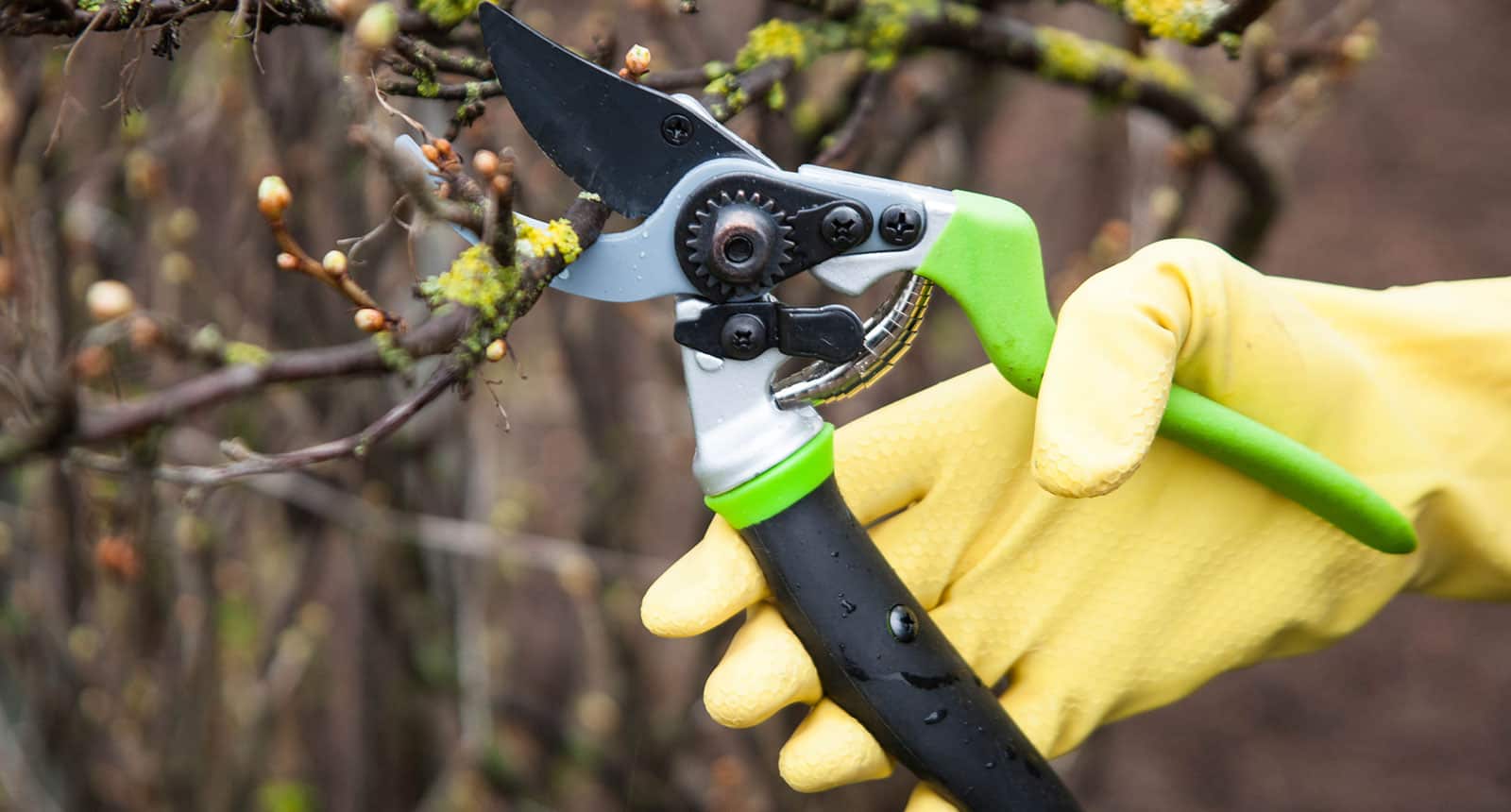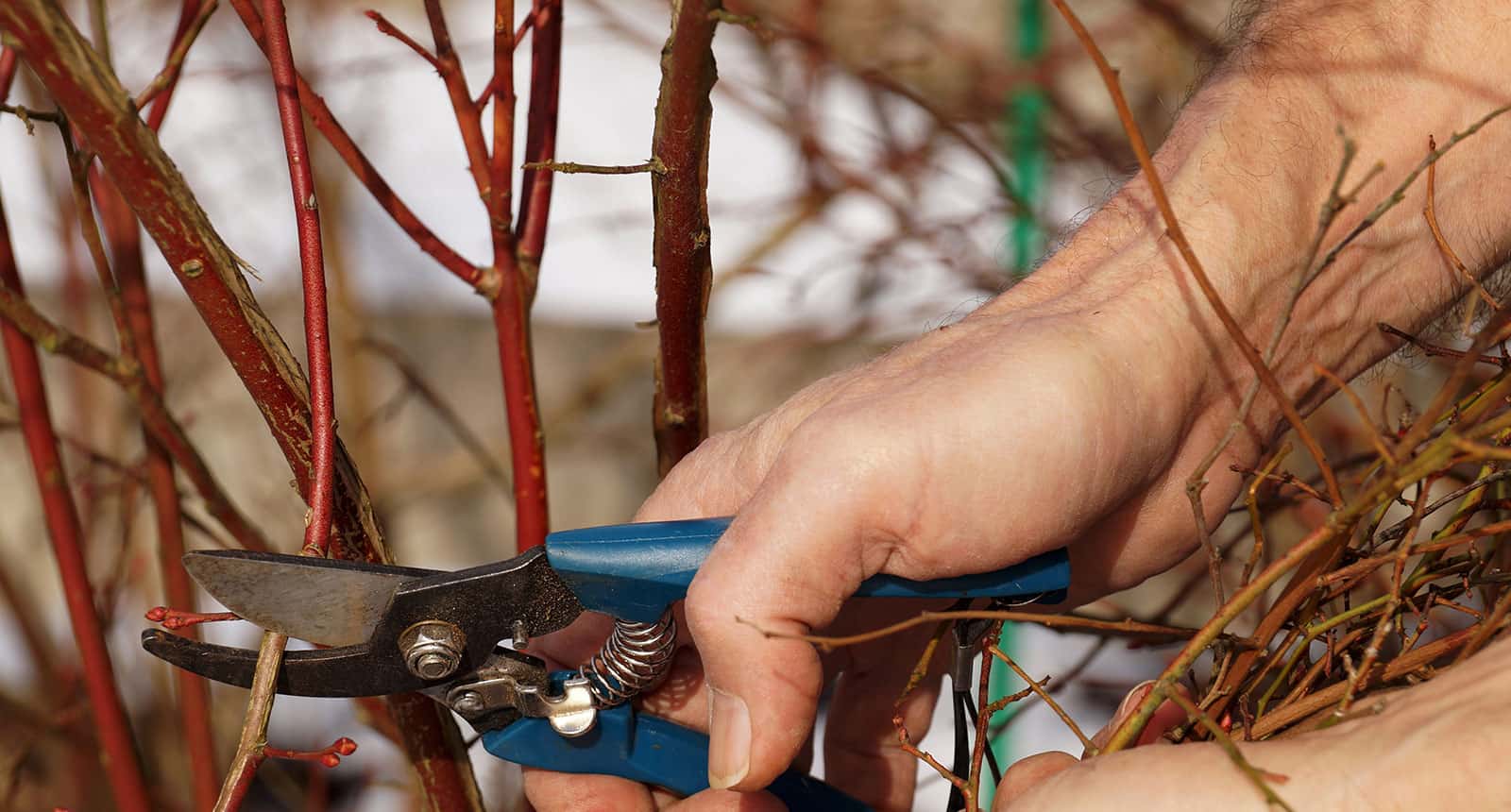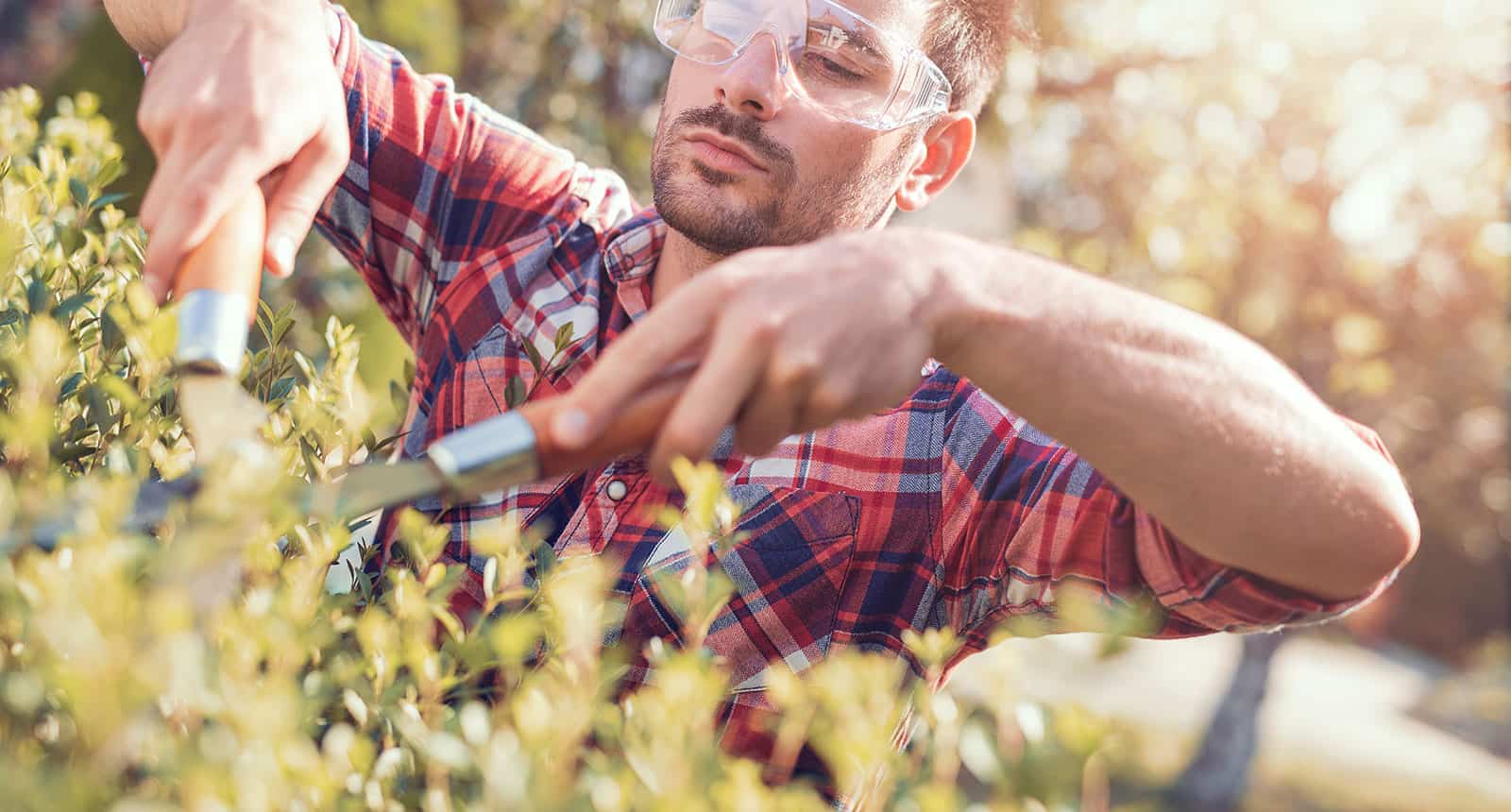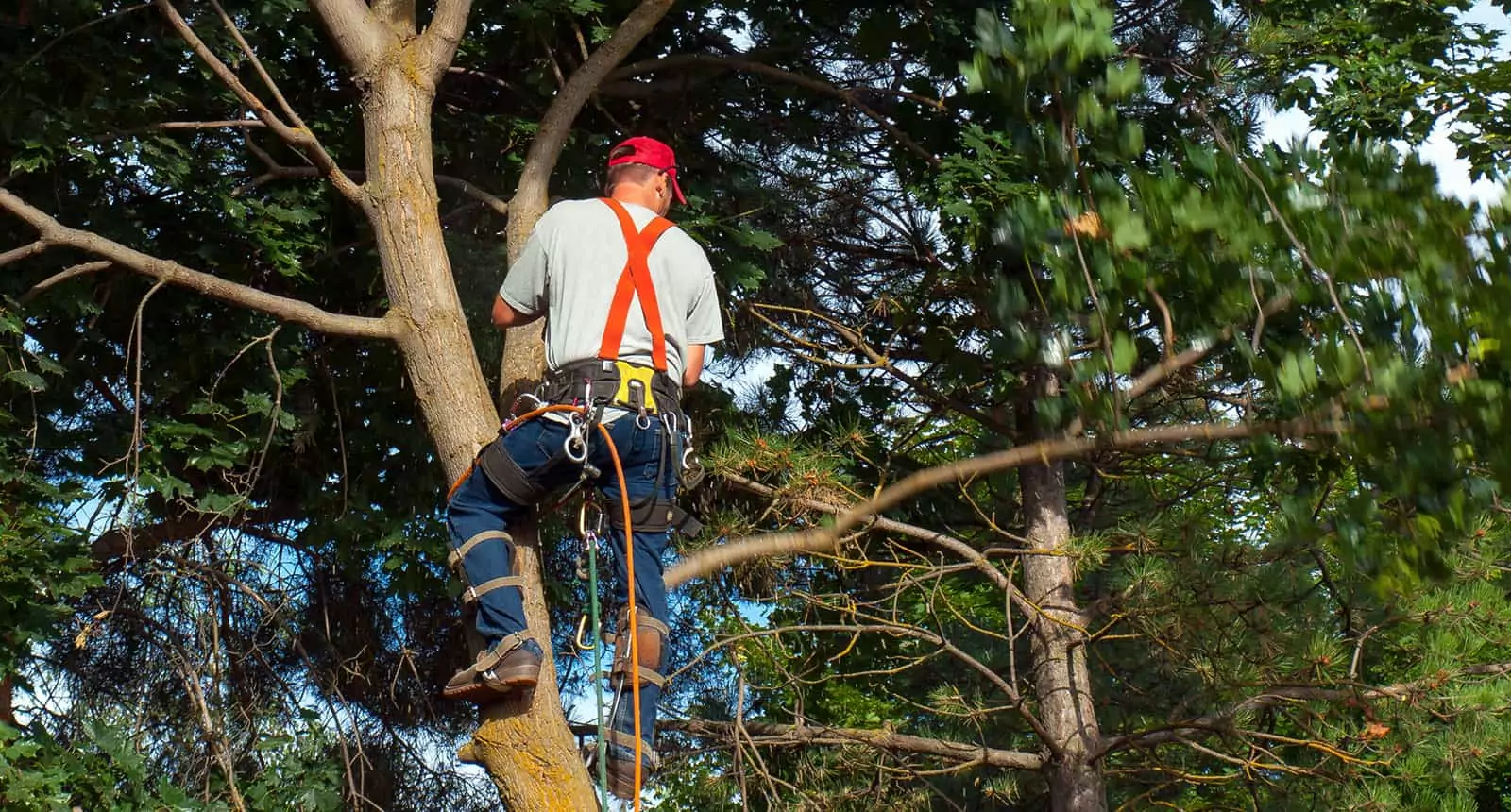Knowing when to trim your trees and shrubs and the proper way to do it improves your landscape appearance and the longevity of the plants. Even though trees grow on their own without trimming, you should maintain them every year.
Most people believe fall is the best time to prune trees. I can see why someone would think fall is the best season for trimming. It is easier to see where to cut when the foliage is gone, but you should wait a couple of months.
The ideal time to trim most trees is actually late winter or early spring. I will cover the reasons behind it in the article, as well as some basic techniques for trimming different trees and shrubs.
Quick Answers: When to Trim Your Trees and Shrubs
Check the table for a quick guide on when and how to trim trees and shrubs. Keep reading for more detailed instructions!
| Type | Species | When to trim | Pruning Techniques | |
| Conifers | Random-branching pattern | arborvitae, hemlock, juniper, yew | Late Winter | Clean cuts of dead branches, crowded branches |
| Whorled-branching | fir, spruce, pine | Removing growth buds | ||
| Non-flowering | Trees | Cycads, gnetum gnemon | Late winter – early spring | Removing branches, dead stems, waterspouts, suckers |
| Shrubs | Burning bush, boxwood | |||
| Spring-Flowering | Trees | Flowering almond, fringe tree, redbud, witch hazel | After blossom period – summer | Removing branches, stems, waterspouts, suckers |
| Shrubs | Azalea, common lilac, Forsythia, Rhododendron | |||
| Summer-flowering | Trees | Crape myrtle, sweet olive, sweet bay | Late winter | Removing branches, stems, waterspouts, suckers |
| Shrubs | Japanese barberry, Bumald spiraea, privet, Sweet shrub | |||
What Is Pruning?
Pruning or trimming refers to removing some parts of a tree or bush. Those can be dead roots, branches, or buds affected by pests, diseases. Additionally, when parts of trees don’t get enough sunlight, they can die and affect the growth of the entire plant and the look.
When you remove dead parts of the plant, you leave more space for fresh, healthy growth. At the same time, it protects it from further damage and stops deterioration.
If you grow fruit trees, pruning is essential for continuous flower products (2). It also enables you to maintain the look and the size of the tree you want. Landscape planning cannot be successful without trimming!

You can see this video to know more:
Types of Trimming
Trimming isn’t only taking hand pruners and randomly cutting branches. It requires planning. Here are the trimming types that you can apply to your garden.
Thinning
Thinning refers to the trimming process in which you cut branches around the trunk but at the base. It is common in garden landscaping because it can make a tree look elegant. It is especially useful if you grow skinny trees.
Topping
Topping is possibly the most dramatic change that requires you to cut almost all branches on top of the tree to the trunk. Experienced gardeners apply it to train some trees to grow the way they want.
Raising
Raising is a procedure that includes trimming the low-hanging parts and branches that come in the way. It is usually applied to the trees around sidewalks and charming trees in the small garden.
Reduction
Lastly, reduction includes removing most of the tree volume. People do it for safety, especially in areas prone to storms.
Tools for Pruning
To ensure the best for the tree’s health and growth and maintain a pleasant look, you need the appropriate tools. There are several tools you can use to prune your trees. Let’s go briefly through the tools that will be sufficient for most trimming tasks.
Secateurs
Secateurs or hand pruners or pruning shears are an essential tool. The tool comes in a variety of sizes and models for left and right-handed people.
In my experience, the 8-inch blade is the most versatile and causes less strain than some larger pruners. Felco Hand Pruners proved to be top-notch and most comfortable to use for a variety of trees.

You can see this video to know more:
Loppers
If your hand pruners cannot complete the task, you need something stronger, such as loppers. You use them to cut thicker branches. Loppers are available in a mini version, lightweight models, etc.
Long-Reach Pruning Shears
As the name suggests, long-reach pruners come with telescopic handles, and you use them to cut out-of-reach stems and branches.
Pruning Saws
If you grow tall trees and thick shrubs, pruning saws with teeth will help you do it in less time and with less effort.
Garden Scissors
Garden scissors are manufactured to help you deadhead flowers and thin stems.
Vivosun gardening shears are something between scissors and hand pruner. I find them very useful for deadheading flowers and trimming shrubs.

When to Trim Your Trees and Shrubs
You might be tempted to bring your shears and start cutting as an act of fall garden clean-up, but you will do more harm to the good. Trimming, among other things, serves to promote new growth.
So, why would you trim trees just before it becomes ready to go dormant?
Therefore, trim it at the end of the dormant season – late winter and early spring to induce fresh, new growth.
Pruning Guidelines From Year One
Some people skip pruning in the first couple of years after planting their tree or shrub. They only take pruning when there are some issues with the plant. But, proper pruning from year one will reward you with healthy, rich foliage and more beautiful flowers (3) .
Here is how to do it in the first year.
Wait until one year passes to prune the tree for the first time. In the meantime, you can remove dead branches and branches that are spaced too tight to each other and block the airflow.
- Once the first year passes, wait until the end of winter to prune the tree to a healthy stem.
- Inspect the plant for dead branches and plan which stems you will cut.
- Wait for a day when with no rain, disinfect your tool and start pruning.
- Inspect the plants for growing suckers from the root, dead or diseased branches, crowded branches, and any limbs that interfere with the tree central line.
- Apply clean cuts to every mentioned part. Clean cuts improve the plant’s ability to heal.
- Cut the branches you need at the base.
- Don’t leave stubs, as they can increase the risk for pests and disease.
- If you are pruning a shrub, cut at the base, and remove one-third of all stems.
Trimming in Second and Third Year
As the tree grows, you should prune it every year at about the same time, applying the above-described procedure.
However, keep in mind that you should never trim more than one-fourth of the tree branches as time goes.
Also, inspecting your developed tree or shrub for branches that grow too close to other branches, parallel, or cross each other is very important.
Cut them to ensure space for growth and proper airflow. When the branches are spaced too closely, they weaken so they can break in stronger wind.
Cut older stems to promote new growth.
You can see this video to know more:
Trimming Developed Tree Branches
As your tree grows, the branches become thicker and stronger. Therefore, you will still have to prune them if they are too close to others, infected with disease, or dead.
Here is the easiest way to trim thick branches. You will need a pruning saw for this task. The process includes making three cuts to remove side branches.
Also, inspect the tree for suckers and waterspouts. You can recognize waterspouts by growing up from the trunk. Suckers grow from the base and weak and thin.
- Find the spot on the limb’s bottom, approximately ten inches away from the trunk.
- Start cutting with a saw to only one quarter.
- Go 1 inch above the cut you just made and cut again.
- Support the branch with your hand as the weight might cause it to break before you complete cutting.
- Finish with the third cut from top to bottom beyond the branch collar.
You can see this video to know more:
When to Prune Every Tree or Shrub?
While pruning in late winter is beneficial for most trees and shrubs, let me get into details and share appropriate pruning timing for all trees.
Conifers
Conifers should be trimmed while trees are completely dormant. However, a pruning technique might be different depending on whether you have a conifer with a random or whorled branching pattern.
Random-Branching Pattern
Conifers such as juniper, hemlock, arborvitae are pruned, applying the teaching I described above. Make thin cuts around the tree trunk, to help the tree keep the desired shape.
Whorled-Branching Pattern
Trees such as spruce and fine have candles – pale growth buds you can notice in the spring. You can prune them with your hands, using your thumb and forefinger to remove them as they are still soft.
You can recognize them by the lighter shade, and that will prevent the growth of new branches. That way, you will maintain the shape of the tree.
Non-Flowering Shrubs and Trees
Non-flowering shrubs overcompensate for the lack of blossoms with shiny and beautiful foliage. Some of my favorites are burning bush and boxwood. Prune them in late winter, during their dormancy stage.
Blooming Trees and Shrubs
For blooming trees and shrubs, there is a difference in pruning time. It depends on whether the trees and shrubs blossom in spring or summer.
If your tree or bush blossoms in summer, trim it in late winter.
Some of the most common and beautiful summer-blooming trees are crape myrtle, southern magnolia, and Japanese pagoda trees.
On the other hand, trees such as eastern redbud, Japanese magnolia, and Taiwan cherry blossom in spring. These trees are the exception to the rule of later winter trimming. You need to trim them after the blossom time. The sooner you do it, the higher benefits it will have for the plant.
What to Do Year-Round?
Once a year, mostly in late winter, you can prune your tree or shrub excessively, but you can do other things year-round.
You can use lopping shear to trim back some branches that stick and ruin the appearance of small trees. Also, you can trim on the sides of conifers and hedges to keep the shape.
However, it is important to remove diseased branches as soon as you notice them. Also, if there is a storm coming, you can check your tree to see if there are weakened branches. I recommend removing them before the storm because clean cuts will help the tree to heal sooner.
The storm might break those branches causing irregular cuts and damage. It will take more time for your tree to heal after that, which can affect the further development of the tree.
What Can Happen if You Don’t Prune Trees?
If trimming seems like an annoying task, let’s discuss what can happen if you don’t do it.
Trees and shrubs will be grown undisturbed, but the damaged branches will fall down eventually. It can cause material damage to nearby objects. Also, trees can grow too close to your home, power lines, or window and destroy the facade or break the windows.
Additionally, if you don’t cut sick branches, they can spread diseases to the rest of the tree, stop fruit producing and kill the tree.
More Tips for Pruning Trees
Always keep your gardening tools clean and disinfected, especially if you have to trim infected parts of the tree. Dirty shears can spread the infection to other plants and tree parts.
Never prune when it is wet outside. Damp weather increases the risk of harmful microbes that will do more harm to your tree than wrong pruning techniques. I suggest you wait for a sunny day to reduce the risk of mold growth and bacteria.
If you have a tall tree that you cannot reach with telescopic pruners, I suggest hiring a professional.

Trimming Trees and Shrubs – Do It Right and Watch Your Trees Thrive
Pruning is essential for keeping the trees and shrubs healthy and your landscape pretty. Most trees and shrubs benefit from pruning in late winter. We should trim only those that blossom in spring after flowering season – in summer and mid-summer.
Despite common misconception, fall is never the right time.
Wait for a sunny day at the end of the winter, clean your tools and trim your tree and shrubs via clean cuts.
If you have more questions about trimming, don’t hesitate to ask me in the comment section!
Please consider liking and sharing the article if you enjoyed it.
References:
- Pruning Shrubs and Trees. (2021). Retrieved 12 May 2021, from https://extension.psu.edu/pruning-shrubs-and-trees
- Marini, R., Sherif, S., & Smith, A. (2020). Physiology of Pruning Fruit Trees. Virginia Cooperative Extension, 025(425).
- Badrulhisham, N., & Othman, N. (2016). Knowledge in Tree Pruning for Sustainable Practices in Urban Setting: Improving Our Quality of Life. Procedia – Social And Behavioral Sciences, 234, 210-217. doi: 10.1016/j.sbspro.2016.10.236
The post When to Trim Your Trees and Shrubs to Strengthen Them and Reduce Infections appeared first on Growing Anything.

